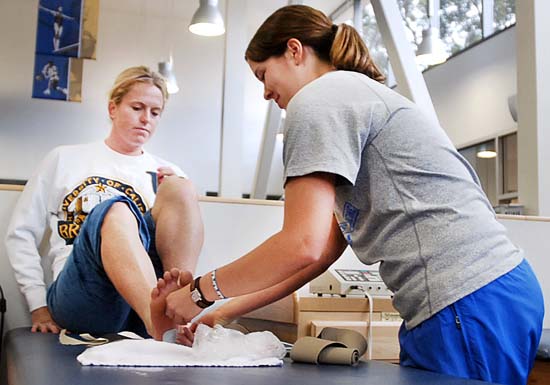At the moment that quarterback Kevin Prince fractured his jaw during the Tennessee football game, Brian Enriquez was standing on the sidelines, watching the medical response unfold right in front of him.
The scene was intense, and noise levels were so high that it was difficult to hear anything that anyone was saying, despite the fact that athletic trainers were yelling.
“It was nuts,” Enriquez, a fourth-year sociology student, said. “He got hurt in the last few moments of the game. I thought when we beat ‘SC (in 2006) was enough, but Tennessee was ridiculous.”
Treatment of serious game injuries, muscle aches and other medical issues fall in the domain of both the official athletic trainers and the UCLA sports medicine interns.
The internship program provides a three-year learning experience, in which students learn how to treat various types of athletic injuries as well as assist with the rehabilitation process, according to the program’s Web site.
The program stresses hands-on work, which is a unique aspect of the internship, said Heather Katzenmeier, an assistant athletic trainer who also works with the internship program.
She added that while many colleges have accredited athletic training programs that focus on developing certified athletic trainers, UCLA is unique in the type of program offered.
Interested individuals usually submit applications during spring quarter of their first year and 45 students are accepted into the program in the fall, Katzenmeier said.
From there, the rookie interns begin their observation period, in which they become oriented with the program and learn skills such as stretching and modalities, which consist of treatments like ultrasounds and electric stimulus.
In addition to learning technical skills, interns are also able to connect with other program participants through the mentor-mentee program, in which new interns are matched up with more experienced students.
These interactions, as well as the development of close relationships with trainers and other interns, create a unique environment for participants.
“We’re like a family,” said Vanessa Reyes, a fourth-year sociology student and sports medicine intern. “We’ve become really close and … we see each other all the time.”
However, this early phase of the program is not without its stress.
At the end of the two-quarter period, interns are assessed based on their competency in technical skills, evaluations from student mentors and staff, an interview and grade point average, Katzenmeier said.
From the original class of 45, 20 interns are eventually chosen to continue the program.
“It’s really stressful,” Reyes said of the observation period. “It was really nerve-wracking … but it was really exciting (when I got in) ““ you work for two full quarters and finally, the work pays off.”
During the second year of the program, interns are assigned to a specific sport and begin attending practices and games as well as treatment sessions.
Interns in this phase typically work about 15-20 hours a week and are compensated with $1000 for the year, Katzenmeier said.
However, the time spent on the job is often seen by interns as a rewarding experience.
“I like being on the sidelines of the games and watching the game,” said April Anthony, a third-year physiological science student who is in her second year of the internship. “I like helping people … and I like that I’m learning a lot because I’m going to be really prepared for physical therapy school.”
Anthony said her duties as an intern for the women’s soccer team include making Gatorade before practices, going to the field with the athletes in case of injury and coming back to the Acosta Athletic Complex afterward for treatments.
Although interns work closely with the athletes, Katzenmeier said that the program teaches students to maintain a professional demeanor.
“We encourage a working relationship,” she said.
The third and final year of the program consists of further assistance to sports teams, the opportunity to travel to away games and the chance to observe an orthopedic surgery on an athlete.
With these increased responsibilities comes a greater average time commitment of 20-25 hours a week and a higher salary of $2000 a year.
“I’m in the midst of football season and we’re concentrating on making a bowl game,” Enriquez said of his current internship assignment. “I’ve been a fan of the team since I was a little kid, so this is really special to me.”
He added that he enjoys the opportunity to travel, afforded to him by the internship.
“I like to go out and see other Pac-10 schools while I can,” he said, adding that one of the most interesting places he’s visited was the University of Washington’s stadium.
“The stadium and the atmosphere were really cool ““ they’re a different breed of fans,” he said. “They’re really passionate and support the team.”
However, this opportunity pales in comparison to his experience at the Rose Bowl.
“Getting to run out of the tunnel with the team was one of the best experiences of my life,” he said. “You see their energy and the energy that fans give us.”
